Abstract
The Hani Rice Terraces are a famous World Heritage Site. The mushroom houses in the terraced fields have a unique architectural style and national cultural characteristics. This study focused on four traditional villages with the most obvious characteristics of mushroom houses: Azheke Village, Dayutang Village, Yakou Village, and Dayazi Village. A total of 34 mushroom houses were mapped. The forms of the mushroom houses were classified first, and then, the basic prototype of the building structure of the Hani mushroom houses was extracted for structural modeling. Finally, the structure of the prototype of the mushroom houses under different load conditions was analyzed. The results show that the Hani mushroom house design has a simple structure and good stability, can adapt to the local natural environment, and is the product of the Hani people’s adaptation to the local natural environment.
1. Background
The Hani people mainly reside in Yunnan, Guizhou, Guangxi, and other regions of China, while a small number are distributed in neighboring Southeast Asian countries, such as Vietnam, Laos, and Thailand. In these countries, they are often referred to as “Hani” or “Ha Nhi”. The distribution of the Hani people in different countries may vary. The language of the Hani people belongs to the Tibeto-Burman language family of the Chinese–Tibetan group [1], and they usually use their own language to communicate.
The Honghe Hani Rice Terraces are a famous UNESCO World Heritage Site [2]. The terraced cultural landscape consists of irrigated rice fields, forested hilltops, and 82 agricultural villages. This landscape was gradually formed by the Middle Hani people over the last 1300 years. The Hani people traditionally reside in mountainous areas, and they mainly lead agricultural lives. The Hani people are skilled in farming and water system construction, and they have built many terraces and irrigation systems that enable them to take advantage of the mountains’ resources. Terraced fields are the main farming method used by the Hani people and are one of the most important symbols of Hani culture [3].
Most current studies on the Hani people focus on terraced landscapes, ecology, tourism, and so on. A literature review shows that the most studied topic is the harmonious coexistence between Hani terraced landscapes and human beings [4,5,6,7,8,9]. Another aspect of the research is related to the sustainable development of mountain terraces [10,11,12]. At the same time, because the Hani Terraces are a famous World Heritage Site, they attract many tourists both from China and from abroad, and there are also a large number of studies on tourism in Hani areas [13,14,15,16,17,18]. There are also numerous studies on the Hani people’s planting of rice [19,20,21,22] and other plant resources [23]. There are also a small number of studies on Hani genetics [24,25], linguistics [26,27,28], social organization [29], and clothing and jewelry [30].
There is relatively little research on the characteristic architecture of the Hani people. The Hani mushroom houses have received a great deal of attention due to a photo taken by the French anthropologist and photographer Yann Layma in 1992 [31]. The Hani mushroom houses are integral to the Hani people’s heritage and have garnered widespread attention and recognition owing to their distinctive aesthetics and cultural significance. Characterized by their unique appearance, these dwellings typically feature a mushroom-like thatched dome atop a rectangular base, hence their moniker, “mushroom houses”. Beyond their physical attributes, these houses hold profound symbolic value within Hani culture, serving as a testament to the Hani people’s deep reverence for the land and nature. As an esteemed cultural heritage site, not only in China but also globally, the Hani mushroom houses continue to attract numerous tourists and enthusiasts eager to explore their rich history. Some scholars believe that the mushroom house is an ecological building type, developed after the Hani people moved to the Ailao Mountains area of Yunnan Province and improved the Pingdiao (Pingdiao) building type, adapting it for the hot and rainy subtropical mountainous monsoon climate [32]. Wang [33] and Zhang et al. [34] mentioned mushroom houses in their study on Chinese folk houses and vernacular architecture. Tang et al. [35] studied the evolution of mushroom houses after the development of tourism. Traditional architectural studies on residential buildings mainly focus on the overall layout of the village and the layout of various architectural functions. Currently, there are scholars employing multidisciplinary approaches to study characteristic architectures in various regions [36]. This paper centers its inquiry on the adaptability of Hani mushroom houses to their local environment. This study employs an architectural approach to analyze the structural form of the mushroom house, beginning with the extraction of its fundamental prototype. Subsequently, structural calculation methods are applied to scrutinize the building’s stability.
2. Materials and Methods
2.1. Research Area
The Honghe Hani Autonomous Prefecture in Yunnan Province is one of the most densely populated areas inhabited by the Hani people. The traditional mushroom houses of the Hani people, the subject of this research paper, constitute the main building type in the traditional villages of the Hani people in the Honghe Hani Autonomous Prefecture. Specifically, there are many mushroom houses in Hani traditional dwelling places, and their shapes are similar. This study selected the buildings in the four traditional villages with the most obvious characteristics of mushroom houses as the research focus. Four typical Hani villages were selected as the study areas: Azheke Village, Dayutang Village, Yakou Village, and Dawazhe Village. These four villages are home to an elderly ethnic Hani population, and they are located far away from urban areas. They best reflect the original appearance of the traditional Hani mushroom houses. A diagram of the location of the study area is shown in Figure 1.
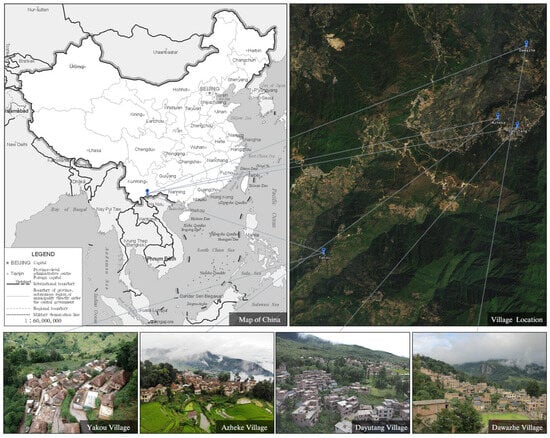
Figure 1.
Study area.
2.2. Research Objects
Houses with the original appearance of mushroom houses in the four villages were selected as the research object. The traditional houses of the Hani ethnic group are known as mushroom houses, so-called because of their iconic four-sided thatched roofs. The main buildings are usually 2–3 stories and made of yellow rammed-earth walls and stone blocks. The main plane is generally rectangular: the first floor is the livestock and utility room, the second floor is the living space, the space under the roof of the third floor is used for stacking sundries, and the third floor is reserved for drying grains. In the investigation of the four villages of the Hani ethnic group (Azheke Village, Dayutang Village, Yakou Village, and Dawazhe Village), Azheke Village and Yakou Village followed the most primitive mushroom houses. There were fewer traditional mushroom houses in Dawazhe Village and Dayutang Village. The thatched roofs of most mushroom houses have been replaced with colored steel tile roofs, and the four-slope roofs have been simplified to double-slope roofs. A total of 34 mushroom houses were analyzed, including 18 in Azheke Village, 6 each in Yakou and Dayutang, and 4 in Dawazhe. At the same time, the mushroom houses in the four villages were numbered for the convenience of the follow-up research. The houses in Azheke were represented by letters K1–K18, the village of Yakou was represented by Y1–Y6, Dayutang was represented by T1–T6, and Dawazhe was represented by Z1–Z4. Typical mushroom houses are shown in Figure 2, where the house numbers can be seen.
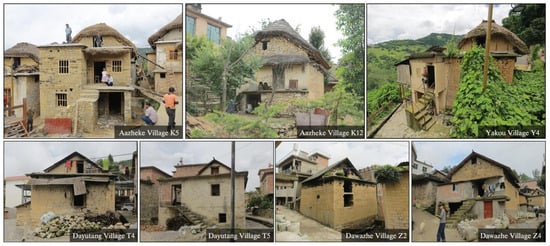
Figure 2.
Appearances of seven representative typical mushroom houses.
2.3. Research Methods
First, the method of architectural typology [37] was used to classify and summarize the mushroom houses. Through the classification of the form and function of the mushroom house buildings, they were organized into a systematic and structural classification system. Finally, we extracted the basic prototype of each mushroom house. Then, the prototype structural model of each mushroom house was calculated.
With the popularization of structure computing technology, more and more scholars have carried out calculations and analyses regarding the structures of residential buildings. Setiawan et al. [38] studied and measured the natural frequency of simple houses, and Shakya [39] studied the seismic performance of masonry buildings composed of wooden frames and masonry structures. Padilla Alquizar and Mendoza Mendoza [40] conducted an analysis of the seismic risk of buildings in the Victor Larco Herrera District, south of Buenos Aires, Peru. Lala et al. [41] compared the seismic performance of different types of bamboo-footed buildings in northeast India. Some other studies have explored the structural performance of low-rise wooden structures and masonry buildings based on different case studies [42,43,44,45,46].
Based on the previous research, this research introduced the mushroom house structural model into SAP2000 for structural analysis. According to the requirements of the design code [47], the effects of the three categories of loads on the building structure (permanent loads, variable loads, and accidental loads) were outlined. The effect design value Sd for basic load combinations should be determined by selecting the most unfavorable effect design value from the following load combination values.
- (1)
- For the effect design value controlled with variable loads, it should be calculated according to the following formula:
In the formula above, γGj represents the partial factors for the j-th permanent load. γQi represents the partial factors for the i-th variable load, and γQ1 represents the partial factors for the dominant variable load Q1. γLi represents the adjustment factors for the design service life of the i-th variable load, and γL1 represents the adjustment factors for the design service life of the dominant variable load Q1. SGjk represents the effective load value calculated from the standard value Gjk for the j-th permanent load. SQik represents the effective load value calculated from the standard value Qik for the i-th variable load, with SQ1k being the controlling contributor in variable load effects. represents the combination value coefficient for variable load Qi, m is the number of permanent loads involved in the combination, and n is the number of variable loads participating in the combination.
- (2)
- For the effect design value controlled with permanent loads, it should be calculated according to the following formula:where the variables are as previously defined. According to the requirements of “GB55001-2021 General Code for Engineering Structures” [48], in this study, γG was taken as 1.3, γQ was taken as 1.5, and C was taken as 0.7.
Generally speaking, the seismic response spectrum is used to calculate the maximum seismic response of a structure, and the ground motion response spectrum reflects the characteristics of the ground motion spectrum and describes the basic characteristics of the seismic response of the structure. The response spectrum, using the maximum seismic influence coefficient αmax as the ordinate, can be expressed as follows:
where m is the structural mass, G is the structural gravity load, Sa is the maximum absolute acceleration, g is the gravitational acceleration, and F is the horizontal seismic force of the system.
3. Results
3.1. Architectural Form
Based on the 34 houses surveyed, the fixed pattern of a Hani mushroom house was determined. First, we considered the overall shape and structure of the house. This kind of building generally has three floors. Due to the geographical location and environmental characteristics of the mushroom house, and because of the local availability of these materials, wood or bamboo are used as the main building materials. The walls are lined with yellow square adobe bricks or stone. There are two kinds of roof: a thatched roof and a colored steel tile roof. The thatched roof assumes a four-slope design, with the grass material exhibiting considerable density, measuring approximately 400 mm in thickness. This four-slope configuration means that each side of the roof, i.e., the front, back, left, and right, has a distinct slope. Notably, there is a lengthy ridge situated between the left and right slopes, with these two slopes being shorter in comparison. The thatched roof is the traditional roofing style adopted in a Hani building, and its designation as a “mushroom house” is due to its resemblance to the rounded lid of a mushroom. Conversely, the colored steel tile roof adopts a double-slope format, featuring thinner tiles with a thickness of no more than 20 mm. In this design, there are only two slopes, one on the left and the other on the right, separated by a prominent central ridge. The ridge of the thatched roof is less conspicuous due to the substantial thickness of the thatching material, while the ridge of the color steel tile roof stands out prominently because of the thinner, more rigid materials used.
The height of a Hani house is closely tied to the dimensions of its thatched roof. This connection stems from the fact that the size of the thatched roof is customarily tailored to suit the house’s height and configuration, ensuring the complete coverage of the structure and the appropriate slope. Selecting the correct roof dimensions and slope is crucial for efficient water drainage and to prevent water from infiltrating the interior of the building. Mushroom houses typically consist of two to three stories with relatively modest heights. The ratio of the house’s height to that of the thatched roof is approximately 3:1, and the pitch of the thatched roof ranges from 30 to 40 degrees. Lower houses feature gentler roof gradients, while taller houses necessitate steeper slopes to ensure swift rainwater runoff and to prevent roof seepage. It is important to note that variations in roof design may exist among different mushroom houses. Terraces are typically situated on the shorter side of the roof, and their presence does not interfere with the drainage or structural integrity of the longer side. Additionally, terraces and the primary entrance are usually oriented in the same direction.
In the investigation, it was found that some houses added low sheds outside the main building, while some houses have extensions that increase their size instead of comprising only the main building. The plane of the main building is generally rectangular or square, comprising three to five rooms of approximately seven to nine meters. The size of each room varies, and the middle one is the largest. The depth is usually three rooms, approximately five to six meters in size, with the largest in the middle. In terms of architectural function, the first floor is used as a utility room or to house livestock, the second floor is used as a living room, and the third floor has a loft and balcony for storing crop ash and drying grain. The first floor is usually left unpaved, while the middle floor functions as a living space, encompassing the bedroom, living room, and kitchen areas, with a central focus on the hearth. The hearth is typically located near the kitchen, and the kitchen area is floored with cement for fire prevention purposes. The remainder of the roof is covered with wooden boards. Therefore, the first and third stories are generally shorter, and the middle one is higher. The first and third floors have no windows, and the second floor has small windows that are roughly square. The interior staircase is narrow and steep, and only one person can go up and down at a time. The steps which lead directly to the door on the second floor are situated outside for easy access. The standard layout of rooms in a mushroom house is shown in Figure 3.
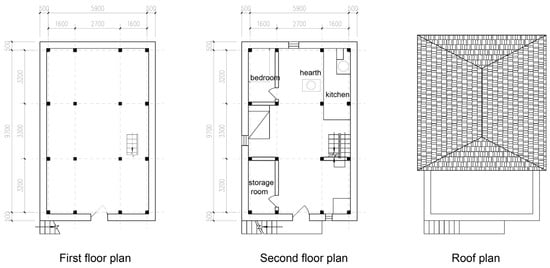
Figure 3.
The standard layout of rooms in a mushroom house.
The main building is divided into morphological categories, of which “I” is the most common, followed by “L” and “T”. The roof plan, building plan, elevation, sections, and photos of six representative buildings are shown in Table 1. The “I” type structure typically comprises the main building, with the terrace extending along the short side or along both the short and long sides. The terrace area matches the main building’s area, resulting in a complete rectangular layout. In contrast, the “L” structure is a variation where the terrace extends along the short side of the “I” structure. Its shape no longer merely extends from the main building but may incorporate the addition of a small room with four or six columns. Consequently, the floor plan evolves from a complete rectangle to nearly an “L” shape. Meanwhile, the “T” structure features a terrace spread only along the long side. The terrace area is of a different size from the main building area, being slightly reduced in size, resulting in a “T”-shaped layout.

Table 1.
Building classification table.
Mushroom houses have a variety of architectural forms, but the building types tend to be consistent. After summarizing the characteristics of mushroom houses and classifying the main buildings, the mushroom houses were modeled and classified, and, finally, a tree diagram of the building types of the mushroom houses was obtained (Figure 4). Among these, the building prototype included the most mushroom rooms, totaling nine. Various forms of mushroom rooms can be derived from this prototype, with the most common modification being the addition of a small volume to the prototype. Furthermore, the shape or orientation of the terrace can be altered. There are two methods of altering the terrace’s shape: by changing its size or changing its shape independently. Additionally, the direction of the terrace can be changed in two ways: switching it to two directions or changing it from the short side to the long side. Similar mushroom houses were integrated into the tree diagram. This study found that compared with the other three villages, Yakou Village experienced the most changes in terms of altering the terrace’s direction. This difference is due to Yakou Village being located in a different mountain col from the other three villages, making it more suitable for lateral house layouts with the terrace oriented toward the sun. After classification, it was found that the basic main structure of a mushroom house is the “I”-type structure, and other structures can evolve from this structure. The colored steel tile roof and the thatch roof differ little in terms of structure, and the most basic mushroom house building types can be selected for structural research.
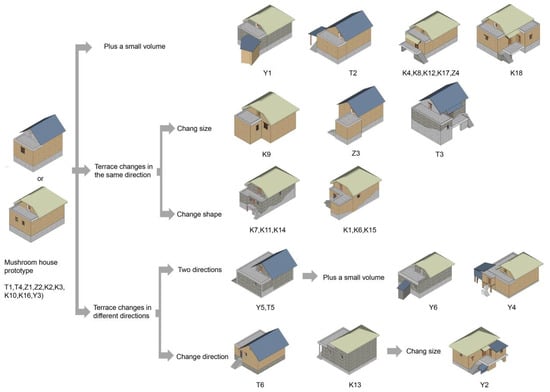
Figure 4.
Tree diagram of building types of mushroom houses.
3.2. Building Structure
According to the architectural structure of mushroom houses, this kind of building has a typical frame structure. The main structure is a wood frame, the filling wall is an adobe brick wall or stone wall, and the roof is a thatched roof or colored steel tile roof. The building sequence for a mushroom house is slightly different from that for a traditional wooden structure. At the beginning of the building process, the wall is first erected, and the post is erected after the column. The first column stands at the 90-degree corner, which gradually develops into the first small square frame, and then the frame is gradually constructed. The first pillar is often regarded as the heart of the building, marking the inception of the entire structure. It frequently supports the initial scaffolding of the building, serving as the foundation upon which other structural elements are added throughout construction. Additionally, it holds symbolic significance, representing the family’s willpower, determination, and aspirations for their new home. The erection of the first pillar is a celebrated event, with families and villagers typically gathering for ceremonies, which often include chicken sacrifices.
The columns of the first and second levels are slightly thicker, wherein the section size is approximately 300 mm × 300 mm. The section size of the columns of the third level is approximately 200 mm × 200 mm. The top of the three floors is provided with diagonal braces, and the section size is approximately 150 mm × 150 mm (Table 2). The main structure of this kind of building is shown in Figure 5. Regarding the construction materials, the wood is usually taken from nearby mountain pine or fir trees. Each village maintains its economic forest, from which the wood for house construction is traditionally harvested. However, recent market influences have led to the purchase of pine wood from external sources. The typical size of the wood does not exceed 300 mm × 300 mm, and it exhibits good adaptability to the mountainous terrain. The material properties are as follows: density—4.5 kN/m3; elastic modulus—1.10 × 107 kN/m2; shear modulus—4.23 × 106 kN/m2; Poisson’s ratio—0.3; and thermal expansion coefficient—1.17 × 10−5.

Table 2.
Component sizes.
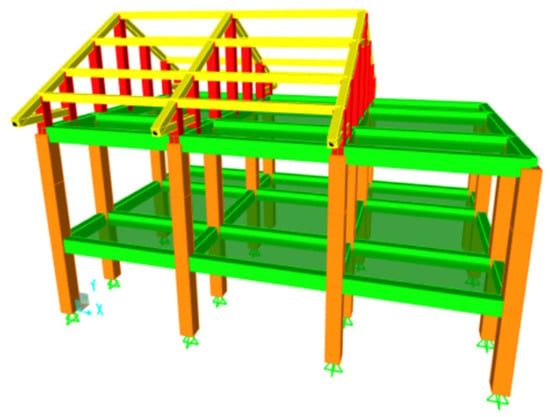
Figure 5.
A mushroom house’s main wooden structure.
3.3. Structural Analysis
- Model building:
In order to study the overall performance of the mushroom house structure, a 3D mechanical model was established using SAP2000 v20 analysis software. This kind of house can be classified as a frame structure. Only the beams and columns of the structure were simulated during modeling, and the column base was set as a solid connection. The mushroom house examined in this paper was constructed with a wooden component frame as its supporting system. Unlike adobe brick structures, there is no constraint between the facade wall and the structure [49,50]. In accordance with the “Technical Standard for Multi-High-Rise Wooden Structure Buildings” GB/T 51226-2017 [51], within eight-degree fortified areas, the height of pure wooden structure buildings should not exceed 17 m, and the height-to-width ratio should not exceed three. The buildings investigated in this paper generally ranged in height from 7.5 to 10 m, with a height-to-width ratio of 0.8–1.5, meeting the current regulatory requirements.
- 2.
- Load and action:
This kind of building is based on the wisdom of the local residents, which has evolved over a long period, and the existing structures have been in use for 40 years. It was assumed that the basic design period of this kind of building structure is 50 years, the design service life is 50 years, the structural safety grade is 3, and the structural importance coefficient is 1.0. According to the relevant regulations of the load code [46] and the field measurement results, the basic wind pressure is 0.45 kN/m2, and the ground roughness is Class B. The seismic fortification intensity of a medium structure in this area is eight degrees (0.20 g), the maximum earthquake impact coefficient is 0.16, the structural damping ratio is 0.05, the site characteristic period is 0.4, and the period reduction coefficient is one. The load combination is 1.0DEAD + 1.0LL + 1.0WX and 1.3DEAD + 1.3DL + 1.5LL + 1.3EX + 1.04EY. The load combinations used in the analysis included 1.0 times the dead load (DEAD), 1.0 times the live load (LL), and 1.0 times the wind load (WX) in the first case. In the second case, the load combination consisted of 1.3 times the dead load (DEAD), 1.3 times an additional dead load (DL), 1.5 times the live load (LL), 1.3 times the earthquake load in the X-direction (EX), and 1.04 times the earthquake load in the Y-direction (EY).
The inter-layer displacement angle under different working conditions is shown in Table 3, demonstrating that these houses meet the structural requirements. According to GB/T 51226-2017, the allowable limit for inter-story displacement angles in pure wooden structures is 1/350. The maximum inter-story displacement angle calculated in this paper is 1/13148, which aligns with the specification’s requirements. The inter-story displacement ratio is mostly less than 1.5.

Table 3.
Displacement angle between floors.
Under DEAD + LL + WX conditions, the maximum displacement range in the X-direction ranges from 0.037 mm to 0.769 mm. The minimum displacement ranges from 0.033 mm to 0.103 mm. The mean displacement ranges from 0.078 mm to 0.436 mm. The maximum displacement in the Y-direction ranges from 0.019 mm to 0.083 mm. The minimum displacement ranges from −0.002 mm to 0.07 mm. The mean displacement ranges from 0 to 0.07 mm.
Under DEAD + DL + 5LL + EX + EY conditions, the maximum displacement in the X-direction varies from 0.06 mm to 0.163 mm. The minimum displacement values range from 0.129 mm to 0.156 mm. The mean displacement values range from 0.134 mm to 0.157 mm. The maximum displacement in the Y-direction ranges from 0.004 mm to 0.031 mm. The minimum displacement values range from 0.012 mm to 0.02 mm. The mean displacement values range from 0.026 mm to 0.031 mm.
Figure 6, Figure 7, Figure 8 and Figure 9 show the deformation in different directions. Compared with that under wind load conditions, the displacement value under earthquake conditions is usually larger. This is because an earthquake exerts a larger horizontal force on the building structure, resulting in greater deformation and displacement of the structure. The analysis of seismic displacement is important to ensure that the building structure will have sufficient toughness and seismic performance during earthquakes.
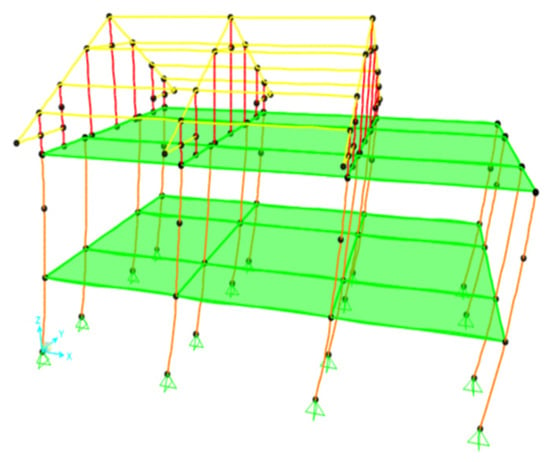
Figure 6.
Deformation diagram of a structure subjected to a wind load in the X-direction.
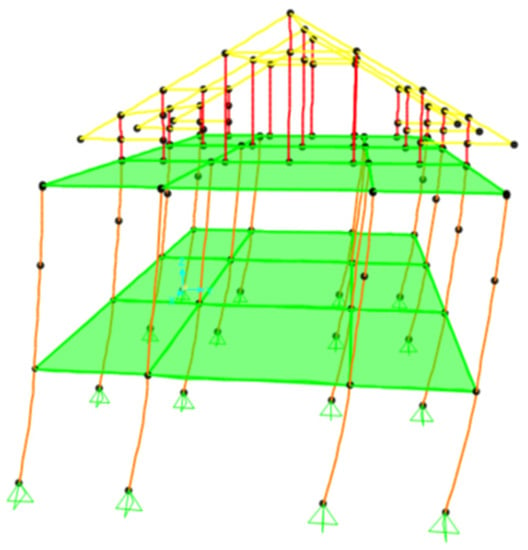
Figure 7.
Deformation diagram of a structure subjected to a wind load in the Y-direction.
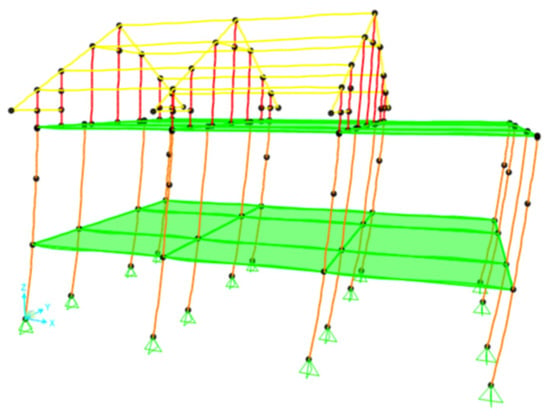
Figure 8.
Deformation map of a structure subjected to an earthquake in the X-direction.
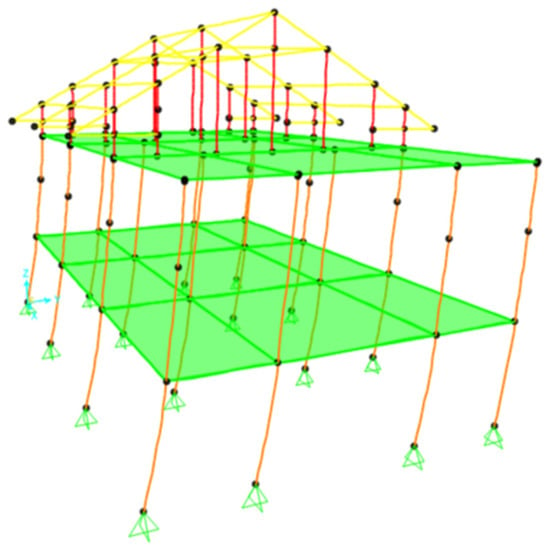
Figure 9.
Deformation map of a structure subjected to an earthquake in the Y-direction.
The above calculations show that the safety and performance of the mushroom house structure meet the relevant requirements.
By analyzing the natural vibration characteristics of the structure, the vibration modes and corresponding periods of the structure were calculated. Then, the modal mass was used to describe the mass participation degree of the vibration modes in different directions. The first three modes and corresponding periods of the structure are T1, a period of 0.202 s, with a mass participation coefficient in the X-direction of 0.913; T2, a period of 0.176 s, with a mass participation coefficient in the Y-direction of 0.905; and T3, a period of 0.156 s, with a mass participation coefficient in the Z-direction of 0.905. The participation coefficients of the modal mass are shown in Table 4. The overall stiffness distribution of the structure is uniform, and the integrity of the structure is good.

Table 4.
Participation coefficients of modal mass.
Based on the above analysis, the displacement of the mushroom house structure under wind and earthquake loads is minimal, and the displacement angle between layers remains relatively consistent. Additionally, the modal mass participation coefficient exceeds 90%. These characteristics indicate that the structure possesses ample stiffness to withstand external loads and resist deformation, thus contributing to its stability and seismic performance.
4. Discussion
Generally speaking, mushroom buildings are not high, and their scale is appropriate; they have a wooden structural skeleton and adobe brick or stone as the enclosure, their walls are thicker, and they have few windows. The first layer is relatively low, and it is mostly used for storage or livestock. Because the local climate is humid, the first layer is not suitable as a living space. The main structure is a wooden structure, and the wood is produced locally and can be found in the mountains. The walls are not load-bearing. Adobe is also unique to the local area, and it is made of grass and mud. Because of the humid climate, the bottom of the wall is made of multi-purpose stone or is coated with waterproof material.
According to the morphological classification of mushroom houses, the “I” type is the most common, followed by the “L” type and the “T” type. A variety of forms of the mushroom house can be developed from the “I” form. The displacement angle between the layers of the main structure is small, and the structure is relatively stable when bearing loads; there is no excessive displacement or deformation. Under wind load conditions, the displacement of the floors is small, and the average displacement value is close to zero, which means that the displacement of buildings under wind loads is small, the response of the structures to wind loads is stable, and they can maintain good structural performance. The displacement value of the floor is relatively small under earthquake conditions, and the structure responds reasonably to earthquakes, effectively absorbing seismic energy without excessive displacement and deformation, maintaining the stability of the building. In addition, it is noteworthy that the modal mass participation coefficient exceeds 90%. This signifies that a significant portion of the structural mass actively participates in the dynamic response of the structure under seismic loads.
In this study, we failed to analyze and study the nodes of each wooden structure and we did not compare the structure of each form of mushroom house. We hope that other scholars can continue to improve on our work in subsequent studies. We primarily focused on the wooden frame structural system. It is true that our previous method primarily considered the conversion of mass from infill walls or enclosure surfaces using line or area load patterns. When seismic loads were applied, we did consider reducing the structural period to account for the influence of infill walls on structural stiffness. Future research endeavors will encompass a detailed examination of the in-plane behavior of the building’s facade walls and their interactions with the wooden frame structure. This will contribute to a more comprehensive evaluation of the structural stability of the building under varying loading conditions. This research direction will further enhance our understanding of these unique building systems.
The traditional houses of the Hani people have a unique architectural style, known as mushroom houses, and exhibit ethnic and cultural characteristics, which not only adapt to the local geographical environment but also demonstrate the wisdom of the Hani people and their respect for nature. Although the structure has not been modernized, it can be called a building without an architect. The conclusions of this study are similar to those of previous studies in other areas [52]. Traditional Hani mushroom houses represent a unique architectural form rooted in the local natural environment and cultural traditions. These mushroom houses are not just dwellings, they also demonstrate an intelligent response to the local geographical and climatic conditions. They are the result of generations of Hani wisdom. This construction technique has demonstrated remarkable earthquake resistance and durability over centuries. However, this traditional architectural form is gradually facing challenges in modern life, necessitating improvements and adaptations. To begin with, traditional mushroom rooms generally have smaller interior spaces, which do not align well with the lifestyles of modern families. Family members often require more privacy and independence, along with the modern amenities and conveniences of contemporary life. Therefore, the interior structure of traditional mushroom houses must be redesigned to meet the needs of modern living. Moreover, the maintenance of mushroom houses is more demanding than that of modern buildings. These houses use wooden structures and thatched roofs, requiring regular thatch replacement and addressing issues such as insect infestation, moth infestation, and moisture protection. The utilization of modern building materials and technologies can extend the service life of mushroom houses and reduce maintenance costs. Today, although the architectural style of some villages has changed, with fewer and fewer thatched mushroom houses, traditional houses are still an important part of Hani culture and deserve our attention and research.
Author Contributions
Conceptualization, X.B. and Y.D.; methodology X.B.; software, Y.D.; validation, Y.D.; formal analysis, X.B.; investigation, X.B.; data curation, X.B.; writing—original draft preparation, X.B.; writing—review and editing, D.L.; project administration, D.L.; funding acquisition, D.L. All authors have read and agreed to the published version of the manuscript.
Funding
This research received no external funding.
Data Availability Statement
The data will be made available upon request.
Conflicts of Interest
The authors declare no conflict of interest.
References
- Hua, H.; Zhou, S. Human-environment system boundaries: A case study of the Honghe Hani rice terraces as a world heritage cultural landscape. Sustainability 2015, 7, 10733–10755. [Google Scholar] [CrossRef]
- World Heritage Site Hani Rice Terraces. Available online: https://www.worldheritagesite.org/list/Hani+Rice+Terraces (accessed on 18 June 2023).
- Gao, Y. Top-down and bottom-up processes for rural development and the role of architects in Yunnan, China. Buildings 2016, 6, 47. [Google Scholar] [CrossRef]
- Shaowen, H.; Hanqi, H. Ecological cultures of traditional Hani villages. J. Landsc. Res. 2017, 9, 87–93. [Google Scholar]
- Jiao, Y.; Li, X.; Liang, L.; Takeuchi, K.; Okuro, T.; Zhang, D.; Sun, L. Indigenous ecological knowledge and natural resource management in the cultural landscape of China’s Hani Terraces. Ecol. Res. 2012, 27, 247–263. [Google Scholar] [CrossRef]
- Lili, W.; Zheng, Y. The research on Qingkou Hani’village from perspective of ecolgoy. In Proceedings of the 2011 International Conference on Remote Sensing, Environment and Transportation Engineering, Nanjing, China, 24–26 June 2011; IEEE: Piscataway, NJ, USA, 2011; pp. 3705–3708. Available online: https://ieeexplore.ieee.org/abstract/document/5965132 (accessed on 18 June 2023).
- Zhan, G.; Jin, Z. Hani rice terraces of honghe-the harmonious landscape of nature and humans. Landsc. Res. 2015, 40, 655–667. [Google Scholar] [CrossRef]
- Ding, Y.; Liu, Z.; Jiao, Y.; Xu, Q.; Zhang, K.; Liu, C.; Chen, F. A bi-scale assessing framework for aesthetic ecosystem services of villages in a world heritage site. J. Mt. Sci. 2022, 19, 874–891. [Google Scholar] [CrossRef]
- Liu, M.; Liu, W.; Yang, L.; Jiao, W.; He, S.; Min, Q. A dynamic eco-compensation standard for Hani Rice Terraces System in southwest China. Ecosyst. Serv. 2019, 36, 100897. [Google Scholar] [CrossRef]
- Liu, Y.; Liang, T.; Jing, W.; Xia, L. Study on Water Resource Vulnerability Evaluation of Hani Terrace Core Area in Yuanyang, Yunnan. Procedia Earth Planet. Sci. 2012, 5, 268–274. [Google Scholar]
- Ma, X.; Shi, Y.; Zhang, S.; Yang, J.; Guo, L. Analysis of the impact of traditional ethnic villages in Hani area on sustainable development. PLoS ONE 2023, 18, e0283142. [Google Scholar] [CrossRef]
- Zhang, Y.; Zhang, A.; Ma, Y. An integrated mechanism and challenges of mountainous sustainable development: A review of Hani Terraces, China. In Sustainable Development; Wiley Online Library: Hoboken, NJ, USA, 2023; Available online: https://onlinelibrary.wiley.com/doi/abs/10.1002/sd.2651 (accessed on 18 June 2023).
- Walter, P. Tourism and forest management among the Hani in Xishuangbanna, China. In Globalization and Indigenous Peoples in Asia: Changing the Local-Global Interface; SAGE Publications India Pvt Ltd.: Delhi, India, 2004; pp. 207–224. [Google Scholar]
- Zhang, Y.; Li, X.; Min, Q. Transportation accessibility of central towns in Important Agricultural Heritage Systems sites in mountainous areas and its impact on local economic development: A case study of Honghe Hani Rice Terraced System, Yunnan. J. Resour. Ecol. 2019, 10, 29–38. [Google Scholar] [CrossRef]
- Qu, C.; Zhang, C.; Shen, S.; Olsen, D.H. Heritage conservation and communities’ sense of deprivation in tourism: The case of the Hani community in Yunnan, China. Tour. Geogr. 2023, 25, 881–898. [Google Scholar] [CrossRef]
- Gao, J.; Lin, H.; Zhang, C. Locally situated rights and the ‘doing’ of responsibility for heritage conservation and tourism development at the cultural landscape of Honghe Hani Rice Terraces, China. J. Sustain. Tour. 2021, 29, 193–213. [Google Scholar] [CrossRef]
- Chan, J.H.; Iankova, K.; Zhang, Y.; McDonald, T.; Qi, X. The role of self-gentrification in sustainable tourism: Indigenous entrepreneurship at honghe hani rice terraces world heritage site, China. J. Sustain. Tour. 2016, 24, 1262–1279. [Google Scholar] [CrossRef]
- Jie, S. Tourist tales: A case study on Photography Tourism in Yuanyang, China. Senri Ethnol. Stud. 2010, 76, 111–130. [Google Scholar]
- Li, J.; Jiao, W.; Min, Q.; Li, W. Effects of Traditional Ecological Knowledge on the Drought-Resistant Mechanisms of the Hani Rice Terraces System. J. Resour. Ecol. 2016, 7, 211–217. [Google Scholar] [CrossRef]
- Xu, H.; Wang, Q.; Bai, J.; Xiao, R.; Gao, H.; Cui, B. Changes of phosphate and ammonium nitrogen in irrigated waters of Hani terrace wetlands along the elevation gradients. Procedia Environ. Sci. 2010, 2, 1368–1373. [Google Scholar] [CrossRef][Green Version]
- Wang, H.; Wang, Y. Factors influencing indigenous rice protection in the Yuanyang terraced rice fields of China. J. Resour. Ecol. 2017, 8, 287–295. [Google Scholar] [CrossRef]
- Yang, J.; Xu, J.; Zhou, Y.; Zhai, D.; Chen, H.; Li, Q.; Zhao, G. Paddy Rice Phenological Mapping throughout 30-Years Satellite Images in the Honghe Hani Rice Terraces. Remote Sens. 2023, 15, 2398. [Google Scholar] [CrossRef]
- Fu, Y.; Chen, J.; Guo, H.; Chen, A.; Cui, J. Utilisation and conservation strategies for plant resources in tropical montane agroecosystems: A case study from Xishuangbanna, SW China. Int. J. Biodivers. Sci. Manag. 2008, 4, 32–43. [Google Scholar] [CrossRef]
- Zhao, F.; Song, L.; Peng, Z.; Yang, J.; Luan, G.; Chu, C.; Ding, J.; Feng, S.; Jing, Y.; Xie, Z. Night-time light remote sensing mapping: Construction and analysis of ethnic minority development index. Remote Sens. 2021, 13, 2129. [Google Scholar] [CrossRef]
- Liu, L.; Yao, J.; Huang, Y.; Gao, L.; Dai, J.; Yuan, X.; Zhang, X.; Nie, X.; Hu, L. Genetic polymorphisms of 16 X-STR loci in the Hani population from Southwest China. Forensic Sci. Res. 2022, 7, 196–201. [Google Scholar] [CrossRef] [PubMed]
- Bradley, D. Tibeto-Burman languages of PDR Lao. Linguist. Tibet. Burman Area 1996, 19, 19–27. [Google Scholar]
- Wang, X. Research on Aesthetic Value of Twelve Ancient Songs of Hani People’s Ancient Songs. In Proceedings of the 4th International Conference on Management Science, Education Technology, Arts, Social Science and Economics, Jinan, China, 15–16 October 2016; Atlantis Press: Amstelkade, AV, USA, 2016; pp. 1360–1363. Available online: https://www.atlantis-press.com/proceedings/msetasse-16/25865353 (accessed on 18 June 2023).
- Bradley, D. Language policy for China’s minorities: Orthography development for the Yi. Writ. Lang. Lit. 2009, 12, 170–187. [Google Scholar] [CrossRef]
- Guo, W. Placeness production of sacred space, resident identity differentiation and daily resistance: A case study of Qingkou village of Hani nationality in southwest China. Tour. Trib. 2019, 34, 96–108. [Google Scholar]
- Zhao, X.; Yoon, J.A.; Lee, Y.H. Characteristics of fashion accessories of minorities in Yunnan, China-focused on Bai, Zhuang, Hani, Dai, and the Zang nationality. J. Korea Fash. Costume Des. Assoc. 2018, 20, 109–124. [Google Scholar] [CrossRef]
- Hong, S.K.; Bogaert, J.; Min, Q. Biocultural Landscapes; Springer: Berlin/Heidelberg, Germany, 2014; Volume 2, pp. 158–173. Available online: https://link.springer.com/book/10.1007/978-94-017-8941-7 (accessed on 18 June 2023).
- Huang, S.W.; Hung, H.Q. Ecological Culture Research of Hani traditional Village. Herit. Prot. Res. 2017, 2, 29–37. [Google Scholar] [CrossRef]
- Wang, F. “Houses” Cases. Geo-Architecture and Landscape in China’s Geographic and Historic Context: Volume 2 Geo-Architecture Inhabiting the Universe; Springer: Berlin/Heidelberg, Germany, 2016; pp. 11–105. Available online: https://link.springer.com/chapter/10.1007/978-981-10-0486-5_2 (accessed on 18 June 2023).
- Zhang, M.; Wang, L.; Zhang, Q. Research on Subjective-Cultural Ecological Design System of Vernacular Architecture. Sustainability 2022, 14, 13564. [Google Scholar] [CrossRef]
- Tang, G.; Zhang, J.; Sun, J.; Peng, H.; Zhang, Y. Construction of residential landscape in tourism destination morphology evolution of tourism localization: A case study of the Hani mushroom houses based on local oral history. Trop. Geogr. 2016, 36, 556–563. [Google Scholar]
- Carocci, C.F.; Cannizzaro, F.; Cocina, S.; Di Martino, A.; Finocchiaro, R.; Impollonia, N.; Macca, V.; Terrana, A.; Tocci, C. Preservation of Abandoned Historic Centres—The Case of Poggioreale antica (Sicily). Land 2023, 12, 1376. [Google Scholar] [CrossRef]
- Gui, X.; Ma, Y.; Chen, S.; Ge, G. The methodology of standard building selection for residential buildings in hot summer and cold winter zone of China based on architectural typology. J. Build. Eng. 2018, 18, 352–359. [Google Scholar] [CrossRef]
- Setiawan, B.; Al-Huda, N.; Yulianur, A.; Abdullah, N.; Juellyan, J.; Permana, A.K.; Sawitri, J.I. Natural frequency measurement of modest dwelling houses. Aceh International. J. Sci. Technol. 2022, 11, 190–196. [Google Scholar]
- Shakya, K. Seismic Perfromance of Masonary Building with Timber Frames; Faculty Civil Engineering: Hong Kong, China, 2006; Available online: https://elibrary.tucl.edu.np/handle/123456789/9005 (accessed on 18 June 2023).
- Padilla Alquizar, V.A.; Mendoza Mendoza, J. Análisis de Riesgo Sísmico de las Edificaciones del Sector Buenos Aires Sur-Distrito de Víctor Larco Herrera. Available online: https://renati.sunedu.gob.pe/handle/sunedu/2902120 (accessed on 18 June 2023).
- Lala, S.; Gopalakrishnan, N.; Kumar, A. A comparative study on the seismic performance of the different types of bamboo stilt houses of North-East India. J. Environ. Nanotechnol. 2017, 6, 59–73. [Google Scholar]
- Ahmad, N.; Ali, Q.; Umar, M. Seismic vulnerability assessment of multistory timber braced frame traditional masonry structures. Adv. Mater. Res. 2013, 601, 168–172. [Google Scholar] [CrossRef]
- Susila, G.A.; Mandal, P.; Swailes, T. A Comparison of the Structural Performance of Low-Rise Timber Framed Buildings and Masonry Buildings in a Developing Country (Indonesia). In Proceedings of the Joint Conference APSEC-ICCER, Manchester, UK, 2–4 October 2012; Available online: https://simdos.unud.ac.id/uploads/file_penelitian_1_dir/d69dd61e0d79012c9e4e084bf665e007.pdf (accessed on 18 June 2023).
- Qazi, A.U.; Rasool, A.M.; Ibrahim, Y.E.; Hameed, A.; Ali, M.F. Behavior of Scaled Infilled Masonry, Confined Masonry & Reinforced Concrete Structures under Dynamic Excitations. Buildings 2022, 12, 774. [Google Scholar]
- Xie, Q.; Zhang, L.; Wang, L.; Zhou, W.; Zhou, T. Lateral performance of traditional Chinese timber frames: Experiments and analytical model. Eng. Struct. 2019, 186, 446–455. [Google Scholar] [CrossRef]
- Malone, B.P.; Miller, T.H.; Gupta, R. Gravity and wind load path analysis of a light-frame and a traditional timber frame building. J. Archit. Eng. 2014, 20, B4013001. [Google Scholar] [CrossRef]
- GB 50009-2012; Load Code for the Design of Building Structures. China Architecture and Building Press: Beijing, China, 2012. (In Chinese)
- GB 55001-2021; General Code for Engineering Structures. China Architecture and Building Press: Beijing, China, 2021. (In Chinese)
- Caddemi, S.; Caliò, I.; Cannizzaro, F.; Pantò, B. New frontiers on seismic modeling of masonry structures. Front. Built Environ. 2017, 3, 39. [Google Scholar] [CrossRef]
- Chácara, C.; Pantò, B.; Aguilar, R. Evaluation of the seismic response of a historical earthen structure based on a discrete macro-element modelling approach. In Proceedings of the 7th International Conference on Computational Methods in Structural Dynamics and Earthquake Engineering Methods in Structural Dynamics and Earthquake Engineering, Crete, Greece, 24–26 June 2019; pp. 1391–1400. [Google Scholar] [CrossRef]
- GB/T 51226-2017; Technical Standard for Multi-Story and High Rise Timber Buildings. China Architecture and Building Press: Beijing, China, 2017. (In Chinese)
- Siregar, A.H. Traditional timber house performance in earthquake zone case study: Traditional village of panjalin, west java, indonesia. J. Eng. Sci. Technol. 2021, 16, 4626–4637. [Google Scholar]
Disclaimer/Publisher’s Note: The statements, opinions and data contained in all publications are solely those of the individual author(s) and contributor(s) and not of MDPI and/or the editor(s). MDPI and/or the editor(s) disclaim responsibility for any injury to people or property resulting from any ideas, methods, instructions or products referred to in the content. |
© 2023 by the authors. Licensee MDPI, Basel, Switzerland. This article is an open access article distributed under the terms and conditions of the Creative Commons Attribution (CC BY) license (https://creativecommons.org/licenses/by/4.0/).





























